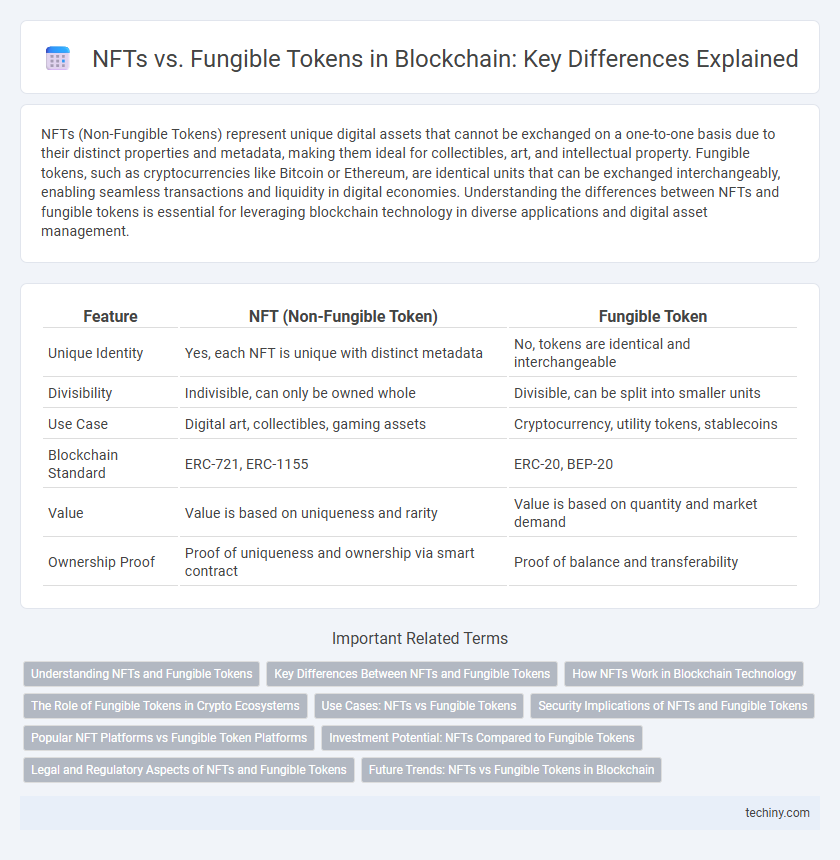NFTs (Non-Fungible Tokens) represent unique digital assets that cannot be exchanged on a one-to-one basis due to their distinct properties and metadata, making them ideal for collectibles, art, and intellectual property. Fungible tokens, such as cryptocurrencies like Bitcoin or Ethereum, are identical units that can be exchanged interchangeably, enabling seamless transactions and liquidity in digital economies. Understanding the differences between NFTs and fungible tokens is essential for leveraging blockchain technology in diverse applications and digital asset management.
Table of Comparison
| Feature | NFT (Non-Fungible Token) | Fungible Token |
|---|---|---|
| Unique Identity | Yes, each NFT is unique with distinct metadata | No, tokens are identical and interchangeable |
| Divisibility | Indivisible, can only be owned whole | Divisible, can be split into smaller units |
| Use Case | Digital art, collectibles, gaming assets | Cryptocurrency, utility tokens, stablecoins |
| Blockchain Standard | ERC-721, ERC-1155 | ERC-20, BEP-20 |
| Value | Value is based on uniqueness and rarity | Value is based on quantity and market demand |
| Ownership Proof | Proof of uniqueness and ownership via smart contract | Proof of balance and transferability |
Understanding NFTs and Fungible Tokens
NFTs (Non-Fungible Tokens) represent unique digital assets verified on a blockchain, ensuring scarcity and indivisibility, often used for digital art, collectibles, and virtual real estate. Fungible tokens like cryptocurrencies (e.g., Bitcoin, Ethereum) are identical, interchangeable units with equal value, facilitating seamless transactions and currency-like functions. Understanding the distinction between NFTs and fungible tokens is crucial for leveraging blockchain technology in asset ownership, trading, and digital scarcity.
Key Differences Between NFTs and Fungible Tokens
NFTs (Non-Fungible Tokens) represent unique digital assets verified on a blockchain, each possessing distinct metadata and indivisibility. Fungible tokens, such as cryptocurrencies like Bitcoin or Ethereum, are interchangeable units with identical value and can be divided into smaller parts for transactions. The primary distinction lies in NFTs' uniqueness and non-interchangeability, making them ideal for digital art, collectibles, and proof of ownership, whereas fungible tokens function as currency or utility tokens within blockchain ecosystems.
How NFTs Work in Blockchain Technology
NFTs (Non-Fungible Tokens) operate on blockchain technology by representing unique digital assets through distinct cryptographic signatures, ensuring each token cannot be exchanged on a one-to-one basis like fungible tokens such as cryptocurrencies. These tokens are stored on decentralized ledgers, which enable immutable proof of ownership and provenance by recording every transaction openly and securely. Smart contracts facilitate the creation, transfer, and management of NFTs, embedding metadata and usage rights directly within the token's code on platforms like Ethereum.
The Role of Fungible Tokens in Crypto Ecosystems
Fungible tokens, such as Bitcoin and Ethereum, play a crucial role in crypto ecosystems by enabling seamless value exchange and liquidity due to their interchangeable nature. These tokens support decentralized finance (DeFi) platforms, facilitate efficient transaction networks, and serve as a backbone for decentralized applications (dApps). Unlike non-fungible tokens (NFTs), fungible tokens ensure uniformity and divisibility, driving mass adoption and utility within blockchain economies.
Use Cases: NFTs vs Fungible Tokens
NFTs enable digital ownership of unique assets such as art, collectibles, and virtual real estate, making them ideal for provenance and authenticity verification. Fungible tokens, like cryptocurrencies or utility tokens, facilitate seamless value exchange and are widely used for payments, rewards, and governance within decentralized applications. Use cases for NFTs emphasize uniqueness and indivisibility, while fungible tokens prioritize liquidity and interchangeability in blockchain ecosystems.
Security Implications of NFTs and Fungible Tokens
NFTs (Non-Fungible Tokens) and fungible tokens differ significantly in their security implications due to their unique attributes; NFTs represent distinct digital assets with individual ownership records, increasing risks related to provenance fraud and ownership disputes. Fungible tokens, such as cryptocurrencies, offer uniform value and interchangeability, which can expose holders to large-scale theft or draining via smart contract vulnerabilities and centralized exchange hacks. Ensuring robust blockchain protocols, thorough smart contract audits, and secure private key management remain critical for mitigating security risks inherent to both NFTs and fungible tokens.
Popular NFT Platforms vs Fungible Token Platforms
Popular NFT platforms such as OpenSea, Rarible, and Foundation specialize in unique digital assets with provable ownership on the Ethereum blockchain, enabling artists and collectors to trade non-fungible tokens securely. In contrast, fungible token platforms like Binance Smart Chain, Uniswap, and Coinbase facilitate the exchange of interchangeable cryptocurrencies such as Bitcoin, Ethereum, and stablecoins with high liquidity and faster transaction speeds. While NFT platforms prioritize uniqueness and provenance, fungible token platforms emphasize seamless token swaps and broad market accessibility.
Investment Potential: NFTs Compared to Fungible Tokens
NFTs offer unique digital ownership with scarcity and provenance, attracting investors interested in rare assets and collectibles. Fungible tokens, such as cryptocurrencies like Bitcoin and Ethereum, provide liquidity and divisibility, making them suitable for traditional investment and trading strategies. The investment potential of NFTs lies in their exclusivity and cultural value, while fungible tokens excel in market stability and volume-driven growth.
Legal and Regulatory Aspects of NFTs and Fungible Tokens
NFTs (Non-Fungible Tokens) and fungible tokens face distinct legal and regulatory challenges due to their inherent differences in uniqueness and interchangeability. Regulatory frameworks often categorize fungible tokens as securities or commodities, subjecting them to established financial regulations, while NFTs present novel issues around intellectual property rights, provenance, and digital ownership verification. Compliance with anti-money laundering (AML) and know-your-customer (KYC) regulations remains essential for both token types, but NFTs require additional scrutiny regarding copyright infringement and provenance tracking under evolving digital asset laws.
Future Trends: NFTs vs Fungible Tokens in Blockchain
Future trends in blockchain indicate increasing integration of NFTs and fungible tokens, with NFTs evolving beyond digital art to represent real-world assets like real estate and intellectual property. Advances in interoperability protocols will enable seamless exchange between NFTs and fungible tokens across multiple blockchain platforms, enhancing liquidity and utility. The rise of fractional NFTs and tokenized ecosystems signifies a shift towards more accessible and diversified digital asset ownership models.
NFT vs Fungible Token Infographic

 techiny.com
techiny.com